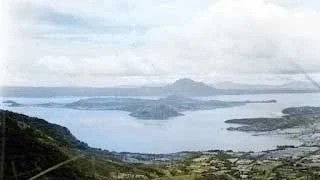In World War II, People Evacuated TO the Taal Volcano Crater Island
Although Taal Volcano Island has long been declared a “permanent danger zone” by the Philippine Institute of Volcanology and Seismology (PHIVOLCS)1, there were, prior to the January 2020 eruption, permanent settlements on the island. The communities in the island’s northern half belonged to the municipality of Talisay, while those to the south were under the jurisdiction of San Nicolas2.
Inhabitants of these communities were, as it happened, displaced and evacuated to centers around Batangas and neighboring provinces in the aftermath of the 12 January eruption. Philippine President Rodrigo Duterte would later declare the volcano island “no man’s land” or off-limits3 with government agencies subsequently floating the notion of making the ban permanent and relocating all the island’s inhabitants.
During World War II, however, when forces of the Japanese Imperial Army occupied the country, it was the volcano island that served as a refuge for Filipinos who wanted to escape the abusiveness of the occupying army. In other words, people were evacuating TO rather than away from the volcano island.
“People were greatly terrified by the Japanese raids and all crossed the lake and fled to the base of Taal Volcano for safety, leaving all their houses, animals, plants and all other properties at the mercy of the merciless Japs. The soldiers got the animals they could catch and slaughtered them for food. They burned houses and cut out straight woody plants such as our valuable lanzones trees, coffee and coconut trees, and used them in making their air raid shelters4.”
“Calingatan is fortunate not to have been affected much by those ravages [in reference to World War II]. The civilians, however, were forced to evacuate to the vicinity of Taal Volcano during the latter part of 1944 to the earliest part of 19455.”
“Many people of the neighboring places went to this place when the Japanese entered the Philippines. Later, all evacuated to Taal Volcano for safety. During those days, some civilians were killed by the enemy and some houses were burned6.”
“During the Japanese occupation, the inhabitants of San Sebastian remained peaceful except during the latter part of the war when [the] atrocities of the Japanese soldiers were already incomparable. The barrio was then depopulated as they all evacuated to Taal Volcano7.”
The historical data documents were by no means complete, so there were in most probability evacuees from the other barrios of Mataasnakahoy who fled to the volcano island as well.
The most descriptive of the narratives offering insights on the evacuation to the Taal volcano island during World War II, however, is from the historical data on Pulang Bato, a barrio belonging to the town of San Nicolas on the island itself:
“At the time of the war between the Japanese and the Americans, the former inhabitants of the barrio returned [to the island]. When the Japanese started massacring people in other barrios such as Bancoro, Saimsim and Maabud, they [the evacuees] went to the barrio of Pulang Bato. They went there to hide and to secure their lives from the Japanese. There were also many from the city who stayed there. These city people paid for sweet potatoes and other food items with their jewelry. The farmers increased their efforts in planting crops. The found hope in their livelihood and some stayed for good, even after the Americans arrived8.”
Mula sa Kasaysayan ng Nayon ng Pulang Bato
Noong panahong labanan ng Hapon at Amerikano, ang mga dating tumira sa nayon ay nangagsibalik. Nang magpapatay na ang mga Hapones sa iba’t-ibang nayon tulad ng Bancoro, Saimsim, at Maabud, sila’y nagsipunta sa nayon ng Pulang Bato. Sila’y doon nagtago upang mailibre ang kanilang buhay sa mga Hapones. Marami rin sa mga taga-siodad ang nanatili roon. Ang mga taga-siodad ay namamalit ng kamote at mga iba’t-iba pang pagkain sa pamamagitan ng kanilang mga alahas. Ang mga mag-aararo noon ay nagsipag ng pagtatanim ng mga anu-ano mang ikabubuhay. Samantalang sila’y nakakakita ng pag-asa sa kanilang kabuhayan ay ang iba’y hindi na umalis doon, kahit sa dumating ang mga Amerikano.
2 “Taal Volcano,” Wikipedia.
3 “ ‘No man's land’: Duterte declares Taal Volcano island off-limits,” by Sofia Tomacruz, published 15 January 2020, online at Rappler.
4 “History and Cultural Life of the Barrio of Bayorbor,” 1953, online at the National Library of the Philippines Digital Collections.
5 “History and Cultural Life of the Barrio of Calingatan,” 1953, online at the National Library of the Philippines Digital Collections.
6 “History and Cultural Life of the Barrio of Lumang Lipa,” 1953, online at the National Library of the Philippines Digital Collections.
7 “History and Cultural Life of the Barrio of San Sebastian,” 1953, online at the National Library of the Philippines Digital Collections.
8 “History and Cultural Life of Pulang Bato, Taal, Batangas,” 1953, online at the National Library of the Philippines Digital Collections.

